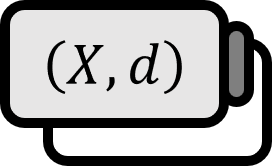Completeness and Density in Metric Spaces
Definition 1
Let’s say for a metric space $\left( X , d \right)$.
- If for every sequence $\left\{ x_{n} \right\}$ in $X$ there exists a natural number $n_{0}$ that satisfies $d(x_{n} , x_{m}) < \varepsilon$ whenever $\varepsilon > 0$ for all $n,m > n_{0}$, it is called a Cauchy sequence.
- If the limiting points of Cauchy sequences in $\left( X , d \right)$ belong to $X$, then $\left( X , d \right)$ is called complete; otherwise, it is incomplete.
- When $\overline{A} = X$, $A$ is said to be dense in $X$.
- When $\left( \overline{A} \right) ^{\circ} = \emptyset$, $A$ is said to be nowhere dense in $X$.
- If $X$ can be represented as the union of countably many nowhere dense subsets of $X$, $\left( X , d \right)$ is called first category; if not, it is referred to as second category.
- $\overline{A}$ and $A^{\circ}$ are the closure, interior of $A$, respectively.
Description
Completeness
The concept of completeness appears to be very similar to that of being closed, often confusing those unfamiliar with topology into thinking of it as being closed. The noticeable difference is that completeness does not require the concept of the entire space, whereas being closed requires the entire space to be defined.
For example, if the entire space for $[a,b)$ is given as $[a,b)$, then it becomes a closed set because it is the entire space. However, since there exists a Cauchy sequence converging to $b$ in $[a,b)$, $[a,b)$ is incomplete regardless of what the entire space is.
However, completeness encompasses a more crucial concept than this intuitive understanding. It guarantees that the sequences of interest in the space of interest converge to elements of interest. The lack of completeness in a space could be likened to finding a solution to an equation in complex numbers when the answer should be real. Regardless of what the answer is, if it’s not in the form we desire, it’s useless, and completeness guarantees that it is.
When first encountering the completeness axiom in analysis, it was difficult to understand why it was called Completeness. In daily life, the English word Complete is not commonly used as ‘fully equipped,’ but rather used alongside ‘completion’ or ‘conclusion,’ denoting the end of something ongoing. Viewing the generalized definition of completeness, the term is apt because it guarantees the existence of the limit point (within that space).
Density
Density is not so much a new concept to learn as it is a way of refining an intuitively understood concept in the manner of topology. Such statements are neat, but sometimes it’s better to explain them in a more elaborate manner. Another way to express it is that for every open set $O \subset X$, if $A \cap O \ne \emptyset$, then $A$ is dense in $X$. The concept of density leads to the notion of a separable space, which is a crucial issue concerning what sequences can or cannot be chosen.
The study of metric spaces is not only of mathematical importance but also conceptually the most intuitive to us humans. Naturally, there’s extensive research on metric spaces and numerous properties regarding completeness.
Category
Baire’s category theorem: All complete metric spaces are second category when considered as a whole set.
Understanding the concept of category can be challenging before actually seeing the theory in action, so for now, it’s best to learn as you go. In the context of Baire’s category theorem, focus more on ‘completeness’ rather than whether it considers itself a whole set or a subset.
Croom. (1989). Principles of Topology: p87~89. ↩︎
